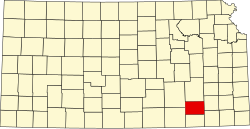Demographics
2020 census
The 2020 United States census counted 570 people, 268 households, and 148 families in Howard. [15] [16] The population density was 808.5 per square mile (312.2/km2). There were 347 housing units at an average density of 492.2 per square mile (190.0/km2). [16] [17] The racial makeup was 90.88% (518) white or European American (89.12% non-Hispanic white), 0.35% (2) black or African-American, 1.23% (7) Native American or Alaska Native, 0.18% (1) Asian, 0.0% (0) Pacific Islander or Native Hawaiian, 1.05% (6) from other races, and 6.32% (36) from two or more races. [18] Hispanic or Latino of any race was 4.56% (26) of the population. [19]
Of the 268 households, 20.1% had children under the age of 18; 44.8% were married couples living together; 35.8% had a female householder with no spouse or partner present. 39.9% of households consisted of individuals and 28.0% had someone living alone who was 65 years of age or older. [16] The average household size was 2.1 and the average family size was 2.8. [20] The percent of those with a bachelor’s degree or higher was estimated to be 21.2% of the population. [21]
23.7% of the population was under the age of 18, 3.3% from 18 to 24, 17.7% from 25 to 44, 25.6% from 45 to 64, and 29.6% who were 65 years of age or older. The median age was 51.5 years. For every 100 females, there were 112.7 males. [16] For every 100 females ages 18 and older, there were 123.1 males. [16]
The 2016-2020 5-year American Community Survey estimates show that the median household income was $39,750 (with a margin of error of +/- $14,890) and the median family income was $61,167 (+/- $6,692). [22] Males had a median income of $38,750 (+/- $13,936) versus $13,500 (+/- $9,870) for females. The median income for those above 16 years old was $26,944 (+/- $7,633). [23] Approximately, 11.4% of families and 23.7% of the population were below the poverty line, including 26.8% of those under the age of 18 and 14.4% of those ages 65 or over. [24] [25]
2010 census
As of the census [26] of 2010, there were 687 people, 318 households, and 176 families residing in the city. The population density was 981.4 inhabitants per square mile (378.9/km2). There were 415 housing units at an average density of 592.9 per square mile (228.9/km2). The racial makeup of the city was 95.1% White, 1.6% Native American, 0.4% Asian, 0.6% from other races, and 2.3% from two or more races. Hispanic or Latino of any race were 4.1% of the population.
There were 318 households, of which 22.3% had children under the age of 18 living with them, 43.1% were married couples living together, 8.8% had a female householder with no husband present, 3.5% had a male householder with no wife present, and 44.7% were non-families. 41.2% of all households were made up of individuals, and 22.7% had someone living alone who was 65 years of age or older. The average household size was 2.03 and the average family size was 2.74.
The median age in the city was 49.6 years. 19.9% of residents were under the age of 18; 6.7% were between the ages of 18 and 24; 17.6% were from 25 to 44; 27.3% were from 45 to 64; and 28.5% were 65 years of age or older. The gender makeup of the city was 47.3% male and 52.7% female.
2000 census
As of the census [26] of 2000, there were 808 people, 350 households, and 215 families residing in the city. The population density was 1,154.6 inhabitants per square mile (445.8/km2). There were 452 housing units at an average density of 645.9 per square mile (249.4/km2). The racial makeup of the city was 94.93% White, 0.25% African American, 1.24% Native American, 0.62% Asian, 0.62% from other races, and 2.35% from two or more races. Hispanic or Latino of any race were 1.98% of the population.
There were 350 households, out of which 24.0% had children under the age of 18 living with them, 51.7% were married couples living together, 6.3% had a female householder with no husband present, and 38.3% were non-families. 37.4% of all households were made up of individuals, and 23.7% had someone living alone who was 65 years of age or older. The average household size was 2.16 and the average family size was 2.83.
In the city, the population was spread out, with 22.4% under the age of 18, 5.4% from 18 to 24, 19.2% from 25 to 44, 22.8% from 45 to 64, and 30.2% who were 65 years of age or older. The median age was 47 years. For every 100 females, there were 81.6 males. For every 100 females age 18 and over, there were 78.6 males.
The median income for a household in the city was $25,822, and the median income for a family was $28,365. Males had a median income of $24,886 versus $16,354 for females. The per capita income for the city was $15,441. About 11.9% of families and 14.5% of the population were below the poverty line, including 17.2% of those under age 18 and 14.6% of those age 65 or over.
This page is based on this
Wikipedia article Text is available under the
CC BY-SA 4.0 license; additional terms may apply.
Images, videos and audio are available under their respective licenses.


